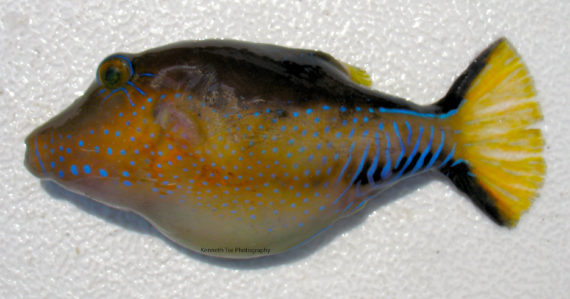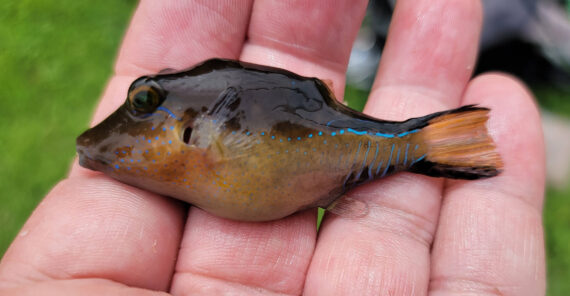Sharpnose Puffer, Canthigaster rostrata
 Sharpnose Pufferfish, Canthigaster rostrata. Fish caught from the Hillsboro Inlet, Hillsboro, Florida, April 2011. Length: 7.6 cm (3.0 inches). Catch, photograph, and identification courtesy of Kenneth Tse, Toronto, Canada.
Sharpnose Pufferfish, Canthigaster rostrata. Fish caught from the Hillsboro Inlet, Hillsboro, Florida, April 2011. Length: 7.6 cm (3.0 inches). Catch, photograph, and identification courtesy of Kenneth Tse, Toronto, Canada.
 Sharpnose Pufferfish, Canthigaster rostrata. Fish caught from coastal waters off Boca Raton, Florida, June 2023. Length: 7.6 cm (3.0 inches). Catch, photograph and identification courtesy of Chris Moore, Peoria, Arizona.
Sharpnose Pufferfish, Canthigaster rostrata. Fish caught from coastal waters off Boca Raton, Florida, June 2023. Length: 7.6 cm (3.0 inches). Catch, photograph and identification courtesy of Chris Moore, Peoria, Arizona.
 Sharpnose Pufferfish, Canthigaster rostrata. Fish caught from coastal waters off Broward County, Florida, August 2021. Length: 8.2 cm (3.2 inches). Catch, photograph and identification courtesy of Ben Cantrell, Sebastian, Florida.
Sharpnose Pufferfish, Canthigaster rostrata. Fish caught from coastal waters off Broward County, Florida, August 2021. Length: 8.2 cm (3.2 inches). Catch, photograph and identification courtesy of Ben Cantrell, Sebastian, Florida.
 Sharpnose Pufferfish, Canthigaster rostrata. Underwater photograph taken in coastal waters off Bonaire, December 2019. Photograph and identification courtesy of Bob Hillis, Ivins, Utah.
Sharpnose Pufferfish, Canthigaster rostrata. Underwater photograph taken in coastal waters off Bonaire, December 2019. Photograph and identification courtesy of Bob Hillis, Ivins, Utah.
The Sharpnose Puffer, Canthigaster rostrata, is a member of the Puffer or Tetraodontidae Family, that is also known as the Caribbean Sharpnose Puffer and in Mexico as tamborín narizón or simply botete. Globally, there are thirty-three species in the genus Canthigaster, of which two are found in Mexican waters, one in the Atlantic and one in the Pacific Ocean.
The Sharpnose Puffer has a robust and slightly compressed body with a depth that is 47% to 51% of standard length. They are dark dorsally transitioning to yellowish-brown mid-body and ventrally. They are covered with small blue spots on their mid and lower body and have a series of blue lines radiating from their eyes, strong vertical lines on their caudal fin base, and a single horizontal line on top of their caudal fin base that transitions to spots under their dorsal fin. They have a prominent yellow tail with wide dark borders making them an easy fish to identify. Their head is large and blunt with large elevated eyes, a small mouth equipped with four fused, strong, and powerful teeth, and a long pointed snout. Their back has a distinctive crest between the eyes and dorsal fin. They have short gill openings that end before their pectoral fins. Their anal fin has 9 rays and is small, has a short base and is found well back in the body, and similar in shape as the dorsal fin; their dorsal fin has 10 or 11 rays and is small with a short base; their caudal fin is rounded or square; and, they do not have pelvic fins. Their skin is smooth and they do not have scales but is tough with a few small spines.
The Sharpnose Puffers are associated with reefs and found in coral reefs, mangroves, and seagrass habitats at depths up to 91 m (300 feet). They reach a maximum of 12.0 cm (4.7 inches) in length. They are daytime omnivores consuming algae, crabs, other crustaceans, hydroids, mollusks, polychaete worms, seagrass, sea urchins, sponges, and starfish, and are believed to be important contributors to many food chains. They hide and become less active at night. They are preyed upon by the the Great Barracuda, Sphyraena barracuda and the highly invasive Red Lionfish, Pterois volitans and utilize their ability to inflate their body with water and can release saxitoxin and tetrodotoxin as defense mechanisms. They are dimorphic with females and males exhibiting different behaviors. Reproduction is oviparous and occurs in harems of up to six individual females establishing vigorously protected territories in mixed coral and rubble, which are maintained by one dominant male. Eggs are deposited demersal into algal nests. They are fertilized externally and are protected by both parents. They have a lifespan of at least ten years.
The Sharpnose Puffer is a resident of all Mexican waters of the Atlantic Ocean including the Gulf of Mexico and the Caribbean.
Due to its very unique coloration, the Sharpnose Puffer cannot be confused with any other species.
From a conservation perspective the Sharpnose Puffer is currently considered to be of Least Concern with stable, widely distributed populations. However, there are long-term concerns about their survival due to the continual decline in the quality and size of their coastal habitats. The Sharpnose Puffers are used extensively by the aquarium trade with fish exported from Caribbean waters. They are difficult to catch by hook and line and most fish are caught in nets as a by-catch.